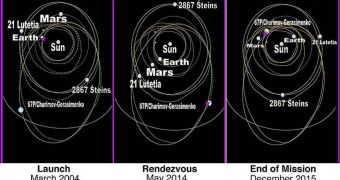The Rosetta spacecraft, a European Space Agency (ESA) mission to an asteroid orbiting at the edge of the solar system, is scheduled to make its final flyby today, November 13. It already completed two similar swings, in 2005 and 2007, and the new flight will provide it with a sufficient speed boost to send it to its designated target. But, as it swings by, astronomers and astrophysicists will keep an eye on minute speed variations that the craft will record, which may hold the key to unlocking a cosmic mystery.
Over the years, as more and more missions through the solar system were launched, and needed to move close to the Earth for the gravity-assist stage, astronomers noticed something peculiar. The space probes seemed to be accelerated differently than estimated, in that they either emerged from the flight moving faster, or slower than anticipated, but never at the “correct speed.” The largest such variation, which is minute by any standards, but scientifically important, was registered by NASA's NEAR spacecraft in 1998, when its speed increased by 13.0 millimeters per second above the calculated value.
“It's a mystery as to what is happening with these gravity events. Some studies have looked for answers in new interpretations of current physics. If this proves correct, it would be absolutely ground-breaking news,” Trevor Morley says. The expert is a Rosetta lead flight dynamics specialist based at the ESA European Space Operations Center (ESOC), in Darmstadt, Germany. Together with orbital mechanics specialist Frank Budnik, Morley was part of a team that tried to find possible explanations for the anomalies Rosetta exhibited as it flew past in 2005.
The team listed a large number of possibilities as to what might have happened, ranging from explanations such as atmospheric drag or reflected radiation from the Earth to things like dark matter, dark energy, or previously unknown variations in Albert Einstein's General Theory of Relativity. Another science team, led by former NASA scientist John Anderson, believes that the planet may be distorting the space-time around it more than previously estimated, which may account for the anomalies. However, none of these ideas has been proven, hence the excitement for today's flight.
“We are using as many ground stations as are available to maximize the amount of swing-by data we record. The more data we get, the better the chance that we may eventually come up with an answer. As it stands now, no one knows what's behind this – it really is a mystery. And your prediction as to whether Rosetta will experience any swing-by speed anomaly at all on November 13 is as good as anyone's,” Morley concludes.

 14 DAY TRIAL //
14 DAY TRIAL //